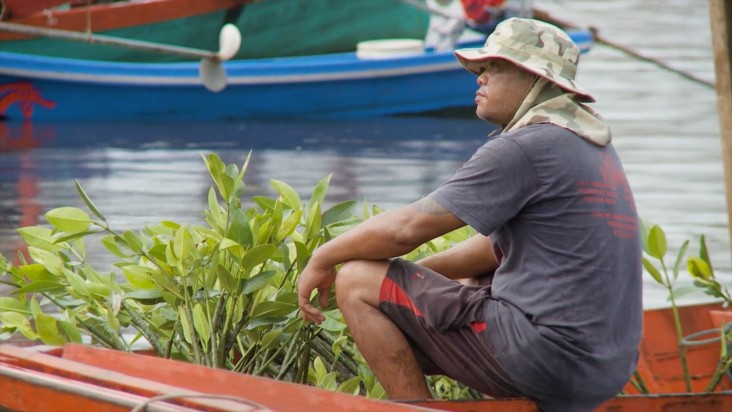
March 2016—Mangrove trees serve as a buffer between land and sea in Cambodia, helping to prevent soil erosion and protect livelihoods. They are also vital to conserving the environment because they serve as a carbon “sink”—storing more carbon than they release.
On average, mangroves can store three to five times more carbon than upland tropical rainforests. As a result, they are key to helping slow carbon emissions and lessen the negative impacts of climate change.
Because most of the trees’ carbon is stored in the soil, measuring that soil for carbon content can be critical to protection and management of natural resources.
Waist-deep in murky, warm water, a group of scientists lift damp earth from beneath mangroves in Koh Kong province. They are part of a USAID-funded team that has spent weeks fighting the swampy heat, mosquitoes and mechanical failures to bring back jars full of mud. Once collected, the mud is scraped into a thin plastic cup and shipped to three different labs around the world to be measured for its carbon content.
“My job is to monitor and oversee this mangrove forest,” said Oui Rann, a forest officer in Koh Kong. “I educate and raise awareness among the local people about the laws on natural conservation.”
The USAID Low Emissions Asian Development program is working in Cambodia’s mangroves—around its great lake, Tonle Sap—to determine their carbon stocks. Data from the mud will help the Government of Cambodia track carbon presence in the mangroves and its subsequent increase or decrease. Armed with this information, they can make decisions on future investments in mangrove conservation management and restoration, preserving this resource and boosting green growth in their country and the region.
As USAID helps bridge the gap between arduous field work and distant labs, scientists and team members are also training the first class of carbon “scholars,” creating a camaraderie and understanding of the importance of these larger issues within the region. Professors from the Royal University of Phnom Penh and Royal University of Agriculture and officials from Cambodia’s Ministry of Environment have been trained on measuring carbon data in mangroves and now share their new knowledge throughout their organizations and communities.
“The first impact is floods, which can destroy homes and infrastructure,” said Rann. “This year, we noticed that there is a delay in the rainfall. Regarding USAID training I attended, this knowledge is good, not just for me but the whole country because we all benefit from it. I will share this knowledge with my children in the future.”
“If we don’t have the mangrove forests, then we can’t make a living,” said Noun Channy, who moved to Koh Kong in 1993 to escape severe droughts east of the country. “We are replanting the mangroves to create a habitat where the fish, crab and shrimp that we catch can live. If our community doesn’t work together, then this mangrove will die off.”
Where land and water meet, Cambodian mangrove forests support a wealth of life, from crabs and monkeys to people, and may be more important to the health of the planet than ever realized. The research carried out by the program may quantify what some conservationalists have been saying for a decade or more: Mangrove forests are among the most carbon-rich habitats on the planet. And that, although they occupy just a fraction of the world’s surface, they pack a punch.
USAID’s Low Emissions Asian Development program, which began in 2011, is designed to help developing countries in Asia achieve sustainable economic growth that is resilient to climate change while slowing the growth of greenhouse gas emissions.
LINKS
Follow @USAIDAsia, on Facebook, on Flickr, on YouTube







Comment
Make a general inquiry or suggest an improvement.